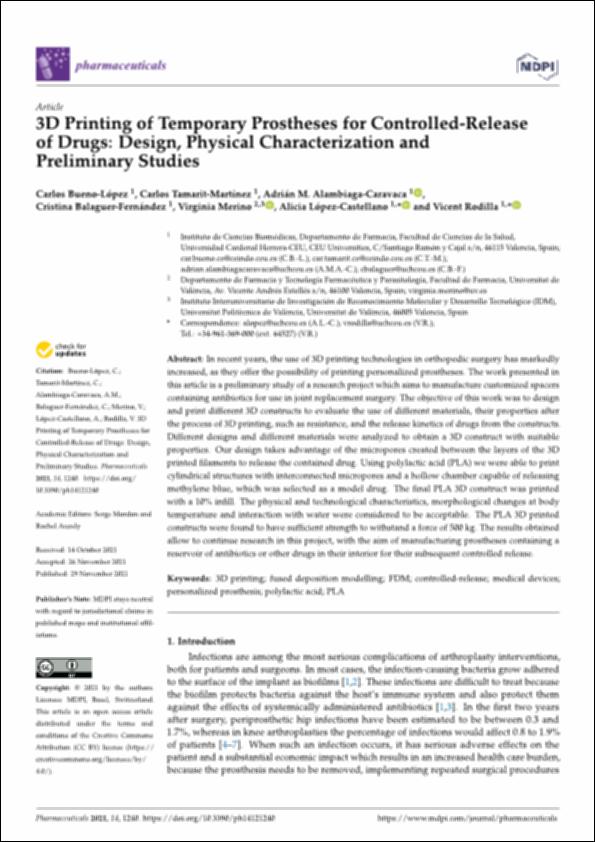Please use this identifier to cite or link to this item:
http://hdl.handle.net/10637/136893D printing of temporary prostheses for controlled-release of drugs : design, physical characterization and preliminary studies
| Title: | 3D printing of temporary prostheses for controlled-release of drugs : design, physical characterization and preliminary studies |
| Authors : | Bueno López, Carlos Tamarit Martínez, Carlos Alambiaga Caravaca, Adrián Miguel Balaguer Fernández, Cristina Merino Sanjuán, Virginia López Castellano, Alicia Cristina Rodilla Alama, Vicente |
| Keywords: | Prosthesis.; Orthopedic surgery.; Ácido poliláctico - Uso terapéutico.; Antibiotics.; Cirugía ortopédica.; Prótesis.; Antibióticos.; Polylactic acid - Therapeutic use. |
| Publisher: | MDPI |
| Citation: | Bueno-López, C., Tamarit-Martínez, C., Alambiaga-Caravaca, A.M., Balaguer-Fernández, C., Merino, V., López-Castellano, A. & Rodilla, V. (2021). 3D printing of temporary prostheses for controlled-release of drugs: design, physical characterization and preliminary studies. Pharmaceuticals, vol. 14, i. 12 (29 nov.), art. 1240. DOI: http://dx.doi.org/10.3390/ph14121240 |
| Abstract: | In recent years, the use of 3D printing technologies in orthopedic surgery has markedly increased, as they offer the possibility of printing personalized prostheses. The work presented in this article is a preliminary study of a research project which aims to manufacture customized spacers containing antibiotics for use in joint replacement surgery. The objective of this work was to design and print different 3D constructs to evaluate the use of different materials, their properties after the process of 3D printing, such as resistance, and the release kinetics of drugs from the constructs. Different designs and different materials were analyzed to obtain a 3D construct with suitable properties. Our design takes advantage of the micropores created between the layers of the 3D printed filaments to release the contained drug. Using polylactic acid (PLA) we were able to print cylindrical structures with interconnected micropores and a hollow chamber capable of releasing methylene blue, which was selected as a model drug. The final PLA 3D construct was printed with a 10% infill. The physical and technological characteristics, morphological changes at body temperature and interaction with water were considered to be acceptable. The PLA 3D printed constructs were found to have sufficient strength to withstand a force of 500 kg. The results obtained allow to continue research in this project, with the aim of manufacturing prostheses containing a reservoir of antibiotics or other drugs in their interior for their subsequent controlled release. |
| Description: | Este artículo se encuentra disponible en la página web de la revista en la siguiente URL: https://www.mdpi.com/1424-8247/14/12/1240 Este artículo pertenece al número especial "Advances in 3D Printed Drug Controlled Delivery Systems and Biomedical Applications". En este artículo también participan: Carlos Tamarit-Martínez, Adrián M. Alambiaga-Caravaca, Cristina Balaguer-Fernández, Virginia Merino, Alicia López-Castellano y Vicent Rodilla. |
| URI: | http://hdl.handle.net/10637/13689 |
| Rights : | http://creativecommons.org/licenses/by/4.0/deed.es |
| ISSN: | 1424-8247 (Electrónico) |
| Issue Date: | 29-Nov-2021 |
| Center : | Universidad Cardenal Herrera-CEU |
| Appears in Collections: | Dpto. Farmacia |
Items in DSpace are protected by copyright, with all rights reserved, unless otherwise indicated.


